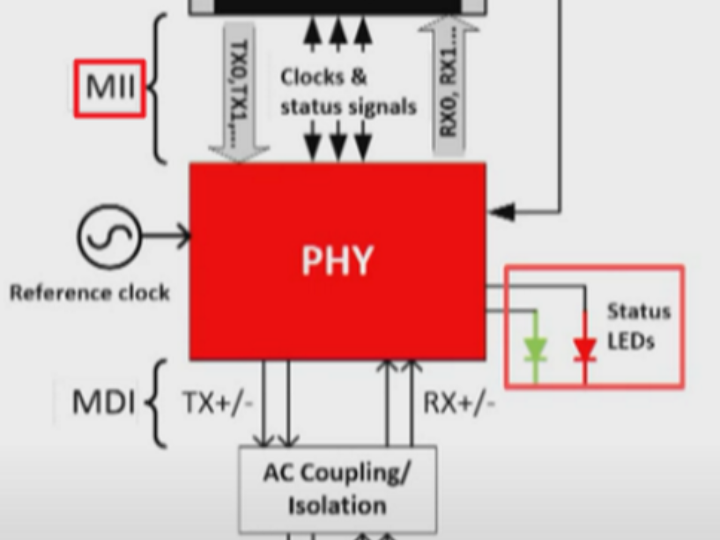IEEE 802.3 10Base-T (1)
convert MDI signal to MII

IEEE 802.3 10Base-T 표준은 이더넷 통신의 초창기 스펙 중 하나로, 특히 UTP (Unshielded Twisted Pair) 케이블을 사용하여 10Mbps의 속도로 데이터를 전송합니다.
UTP 케이블의 주요 차동 신호는 TX+(전송 양성), TX-(전송 음성), RX+(수신 양성), RX-(수신 음성)입니다. 차동 신호의 사용은 외부의 전기적 노이즈나 간섭에 강한 통신을 가능하게 합니다. 그렇기 때문에 이더넷은 다양한 환경에서의 안정적인 데이터 전송을 보장합니다.
PHY (Physical Layer) 칩은 이러한 디퍼런셜 신호를 처리하는 핵심 구성 요소입니다. PHY 내부에서는 먼저 이러한 아날로그 차동 신호가 ADC (Analog to Digital Converter)를 통해 디지털 데이터로 변환됩니다. 이 변환 과정은 신호의 진폭, 주파수, 위상 등의 변화를 디지털 값으로 해석하는 단계를 포함합니다.
변환된 디지털 신호는 그 후 MII (Media Independent Interface) 포맷으로 재포맷됩니다. MII는 PHY 칩과 MAC (Media Access Control) 레이어 사이의 표준화된 인터페이스로, 데이터 전송에 필요한 제어 신호와 함께 4비트 데이터 버스를 사용하여 정보를 주고받습니다. MII 인터페이스는 이더넷의 물리적 특성과 상관없이 일관된 데이터 통신을 제공하는 역할을 합니다.

데이터의 흐름을 자세히 보면, UTP 케이블에서의 차동 신호는 PHY 칩으로 전송되어 아날로그에서 디지털로 변환되고, 그 후 MII 프로토콜에 맞춰 재포맷됩니다. 이렇게 처리된 신호는 MAC 레이어로 전달되어 최종적인 데이터 처리와 네트워크 통신을 위한 패킷 변환 과정을 거칩니다.
다음에 발표할 UIC에서는 UTP 케이블의 차동신호를 직접 오실로스코프로 측정하여 신호를 디코딩하고 그 신호가 Chip 내부에서 어떤 과정을 거쳐서 디지털 신호인 MII signal로 변환되는지 자세하게 포스팅 해보겠습니다.
감사합니다.
The IEEE 802.3 10Base-T standard is one of the early specifications for Ethernet communication, especially transmitting data at 10Mbps using UTP (Unshielded Twisted Pair) cables.
The primary differential signals of UTP cable are TX+ (transmission positive), TX- (transmission negative), RX+ (reception positive), and RX- (reception negative). The use of differential signals allows for communication that is robust against external electrical noise and interference. As a result, Ethernet ensures stable data transmission in various environments.
The PHY (Physical Layer) chip is the core component that handles these differential signals. Inside the PHY, these analog differential signals are first converted into digital data through an ADC (Analog to Digital Converter). This conversion process involves interpreting changes in amplitude, frequency, and phase into digital values.
The converted digital signal is then reformatted into the MII (Media Independent Interface) format. MII is a standardized interface between the PHY chip and the MAC (Media Access Control) layer, which communicates information using a 4-bit data bus along with the necessary control signals. The MII interface provides consistent data communication irrespective of the physical characteristics of Ethernet.

In detail, the differential signals from the UTP cable are sent to the PHY chip where they are converted from analog to digital, and then reformatted according to the MII protocol. These processed signals are then forwarded to the MAC layer for final data processing and packet transformation for network communication.
In the upcoming UIC presentation, we will measure the differential signals of the UTP cable directly with an oscilloscope, decode the signal, and detail how this signal is internally processed in the chip to transform into the digital MII signal.
Thank you.
